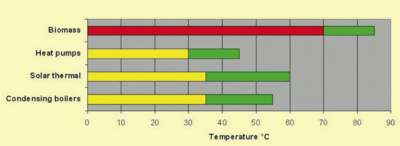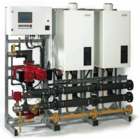Maximising the potential of renewable energy

Renewable energy is potentially inefficient. It is how you apply it that is the key to reducing carbon emissions, as Steve Cooper explains.
Renewable technologies are now in great demand, with the number of projects incorporating low- and zero-carbon (LZC) solutions increasing sharply. We cannot afford to ignore, however, the very real challenges of integrating renewable technologies, such as heat pumps, biomass and solar, with more traditional, but equally valuable, low-carbon solutions, such as the latest generation pumps, heat exchangers, condensing boilers and controls.
The integration of zero-carbon technologies is not as straightforward as end customers might assume.
The development paths of each of these technologies (solar, biomass etc.) have evolved separately from one another. Integration has to overcome fundamental technical differences.
The optimum operating temperatures of the technologies also vary significantly (Fig, 1). The system designer has to integrate low- and zero-carbon elements without forcing any part of the system to operate at a system temperature which compromises its energy efficiency. For example, if the system temperature is designed too high, a condensing boiler will not operate in its efficient condensing mode and the potential carbon savings will be lost.
The methods for overcoming these challenges have to satisfy several requirements.
• Deliver ‘true’ energy-efficiency benefits rather than just notional advantages. The latest low-carbon solutions are capable of significantly higher energy efficiency than has been possible before. It is crucial that the performance of a system incorporating renewables must compete with, or exceed, the very best non-renewables solutions if true carbon savings are to be made. It would be pointless to generate renewable energy and then waste it because the overall system efficiencies have had to be sacrificed to incorporate on-site generation.
• Incorporate ‘as standard’ equipment rather than complicated, bespoke, components. Systems must be cost-effective and easy to maintain. Solutions such as pre-engineered packages, with the potential for configuration to suit the application, are preferable to ‘one-offs’. These can provide competitive capital and lifecycle costs, as well as guaranteeing a secure maintenance regime and sensible upgrade path.
• Offer flexibility. This is a rapidly evolving area of technology and customers may need to adapt systems at a later date.
My company’s design approach for low- and zero-carbon solutions focuses on integrating the renewable devices with a thermal store, combined with an LZC controller, alongside HVAC equipment that is specifically designed for all-variable-speed operation.
There are two types of thermal store.
A sensible-heat store discharges energy via temperature changes within the vessel.
Latent-heat stores discharge heat at a constant temperature.
The first is used more commonly in LZC integration applications whilst the second is more suited to passive heat-storage/release applications.
The thermal store typically performs three functions.

First, it levels out supply and demand. For example, solar energy available during the day can be stored for release at night.
Secondly, it acts as a buffer to prevent boiler cycling and ensure residual heat from a biomass combustion chamber is adequately dissipated.
Finally, a correctly designed thermal store allows us to vertically stratify temperatures. Hot water rises and cold water sinks, so lower temperatures, from solar thermal or heat pumps, are fed into the bottom of the store. Medium temperatures from condensing boilers are fed into the middle of the store, and higher temperatures from biomass are fed in towards the top of the store.
Adjusting to greater variability is a particular feature of any project involving renewables, and this must be reflected in the choice of HVAC components. Traditional HVAC equipment typically does not have the capability to deliver the required flexibility, but that does not mean to say that untried, bespoke equipment is the answer.
Armstrong products such as the MBS integrated heating solution, IVS Sensorless variable-speed drive pumps, Tenantherm thermal interface units, Quantum chiller, and packaged systems built around the IPC integrated plant controller are readily available and proven technologies for renewables projects.
They are all designed for a part-load variable-speed environment. The control technology for these products balances load to demand for the best wire-to-water efficiency at all times. Each component of the system is operated automatically to meet demand whilst, at the same time, exploiting its energy efficiency potential to the full.
These products incorporate BMS-compatible ‘application-specific’ controls that adjust in real-time, with the criteria for energy efficiency pre-designed into the control methodologies. The renewable element of the project is then viewed by the system as simply another contributing factor to the conditions, and the equipment adapts automatically around the renewable-energy input.
A pre-engineered solar heating solution designed to produce domestic hot water at 60°C with back-up from a gas-fired condensing boiler is shown in Fig. 2. It is suitable for DHW loads up to 1600 l per day.
A biodegradable propylene glycol solution is circulated through the solar array by the solar pump station once a predetermined temperature differential is established between TS1 and TS2. The solar array heats the water/glycol mixture which, in turn, heats the lower portion of the stainless-steel solar cylinder. Where there is insufficient solar energy available to achieve 60°C at TS3, the LZC controller automatically brings in the back-up boiler.
The LZC controller ensures that maximum solar energy is utilised whilst ensuring that the back-up boiler operates in condensing mode.
Such solar solutions can satisfy hot-water demands of up to 90 000 l per day and/or support space heating. Other solutions can integrate any combination of biomass, heat pumps, solar thermal and condensing boiler technology.
In conclusion, the challenges of integrating renewables are unavoidable, but solutions are readily available to ensure that ‘true’ carbon savings can be delivered with readily available, proven technology and without complicated bespoke components. Steve Cooper is director of renewables and sustainability with Armstrong Integrated Systems. www.armstrongintegratedsystems.com









